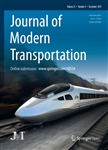Modelling vehicular interactions for heterogeneous traffic flow using cellular automata with position preference
Modelling vehicular interactions for heterogeneous traffic flow using cellular automata with position preference作者机构:Department of Civil Engineering and Transportation Research and Injury Prevention Programme Indian Institute of Technology Delhi Shiv Nadar University
出 版 物:《Journal of Modern Transportation》 (现代交通学报(英文版))
年 卷 期:2017年第25卷第3期
页 面:163-177页
学科分类:08[工学] 082303[工学-交通运输规划与管理] 082302[工学-交通信息工程及控制] 0823[工学-交通运输工程]
主 题:Cellular automata Vehicular interaction ratePosition preference Traffic flow modelling Video-graphic survey
摘 要:This paper proposes and validates a modified cellular automata model for determining interaction rate (i.e. number of car-following/overtaking instances) using traffic flow data measured in the field. The proposed model considers lateral position preference by each vehicle type and introduces a position preference parameter fl in the model which facilitates gradual drifting towards preferred position on road, even if the gap in front is sufficient. Additionally, the model also improves upon the conven- tional model by calculating safe front and back gap dynamically based on speed and deceleration properties of leader and follower vehicles. Sensitivity analysis was carried out to determine the effect of β on vehicular interac- tions and the model was calibrated and validated using interaction rates observed in the field. Paired tests were conducted to determine the determining interaction rates validity of the model in Results of the simulations show that there is a parabolic relationship between area occupancy and interaction rate of different vehicle types. The model performed satisfactorily as the simulated interaction rate between different vehicle types were found to be statistically similar to those observed in field. Also, as expected, the interaction rate between light motor vehicles (LMVs) and heavy motor vehicles (HMVs) were found to be higher than that between LMVs and three wheelers because LMVs and HMVs share the same lane. This could not be done using conventional CA models as lateral movement rules were dictated by only speeds and gaps. So, in conventional models, the vehicles would end up in positions which are not realistic. The position preference parameter introduced in this model motivates vehicles to stay in their preferred positions. This study demonstrates the use of interaction rate as a measure to validate micro- scopic traffic flow models.



